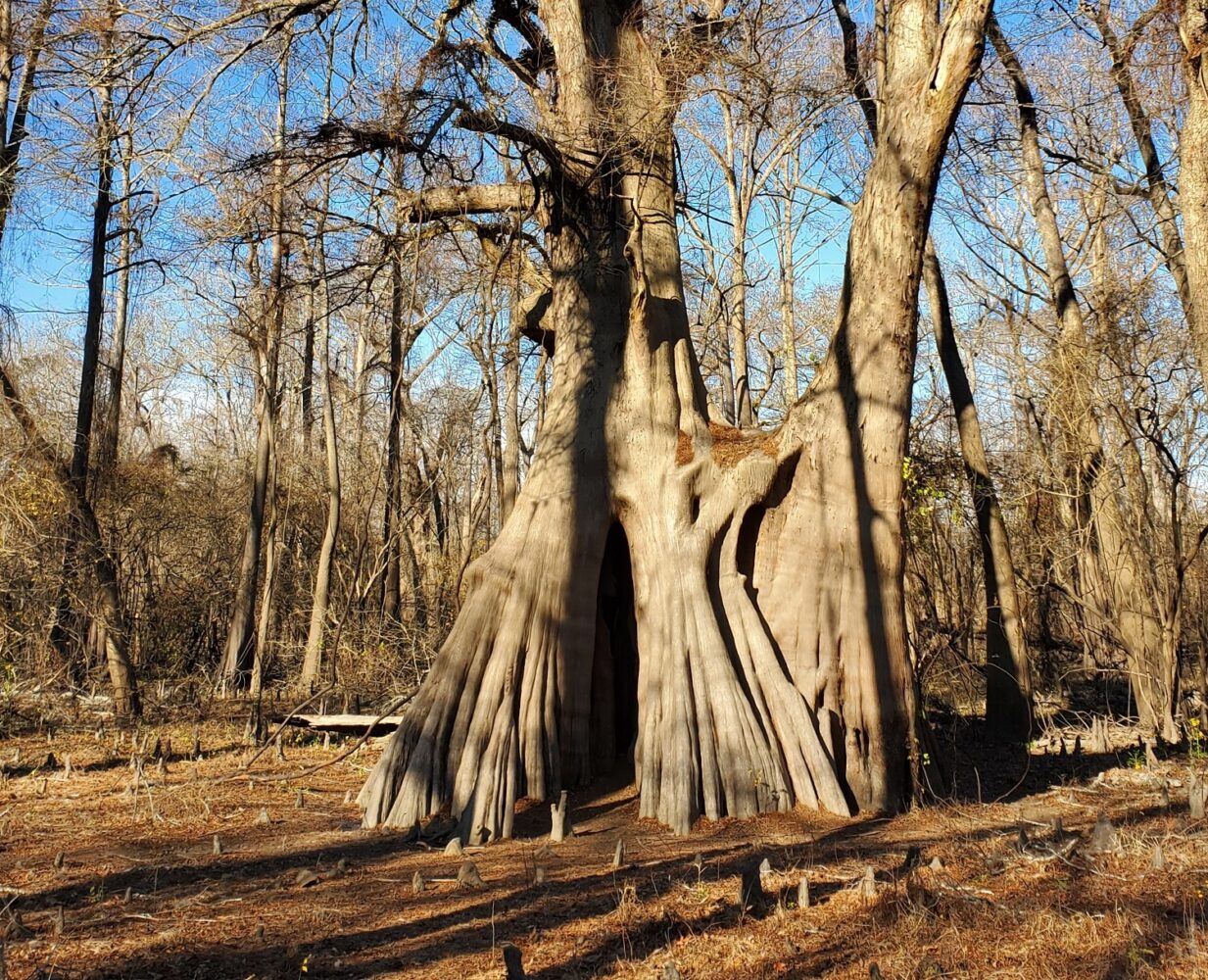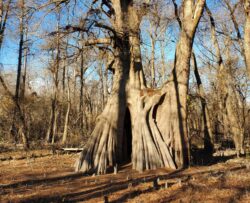Louisiana’s National Champion
No, not LSU (but close)
Published: November 30, 2021
Last Updated: June 1, 2023

Photo by Benjamin Morris
The champion in winter.
Visitors in Louisiana seeking such beauty have no further to go than Cat Island National Wildlife Refuge in St. Francisville, in West Feliciana Parish. There, nearly ten thousand acres of cypress-tupelo swamp and bottomland hardwood forest await, as well as one extraordinary resident that has put Cat Island on the map: the largest bald cypress (Taxodium distichum) specimen in the United States. Ninety-one feet tall, fifty-two feet around, and with a crown spread of eighty-seven feet, it is the largest tree of any species east of the Sierra Nevada mountains, and the sixth-largest tree in the entire country. Trees nominated for National Champion status must undergo a rigorous certification process. Though it was only “crowned” in 2017, the Cat Island cypress, Louisiana’s sole honoree, is estimated to be at least a thousand years old.
For all its celebrity, drawing visitors not just from Louisiana but around the country, the champion is not exactly an arboreal Aphrodite. Unlike its shapely neighbors, it is squat, oddly proportioned. Where the bases of the nearby cypress form pleasing symmetrical cones, the champion’s lumpen feet sprawl across the plain. Where its neighbors’ trunks look smooth and silken, the champion’s trunk has split to form an enormous cavity, and its side growth juts out at such an awkward angle that botanists had to test its DNA to ensure the protrusion had neither been grafted nor overtaken another tree. The champion looks, frankly, like something that crawled (or stomped) out of a Tim Burton film, a creature that would regard any kids frolicking underneath it as a tasty snack.
And yet. Like Shakespeare’s mistress—that famous lady whose eyes were “nothing like the sun” and whose hair was like “black wires”—the champion has something that no other tree in the area has. Majesty. Grandeur. Even mystery. After all, the Bard wrote, “by heaven, I think my love as rare / As any she belied with false compare.”
How did such a specimen survive? Prior to 2000, Cat Island was private land, and had been logged over a century ago—what remains today is largely second-growth. According to William Daniel of the Friends of Cat Island, the champion survived precisely because of its idiosyncrasies: being hollow, it had no commercial value for harvesting, and so was left untouched. What continued irony, then, that its status as an ugly duckling (albeit the largest ugly duckling east of California) not only helped to preserve it then, but also to engender tourism—and therefore revenue—to the area today.
Many states maintain internal records of champion species, but the National Register of Champion Trees seeks to document them across the country. Founded in 1940 by the American Forestry Association (now American Forests), the program highlights the largest living specimens of every tree in order to celebrate and preserve them for future generations. Not only does the program draw attention to the fragility of America’s forest landscapes, inspiring greater efforts for conservation, but one of its side benefits is to increase visitation to those landscapes where the champions are found.
Cat Island shows this in a heartbeat. Here, enthusiasts of the champion bring children and dogs, picnic underneath its branches, sometimes lingering for hours. Excellent though the hunting grounds in the refuge may be, the champion remains Cat Island’s signature draw. Its attractions are more than recreational: in the stillness of the deep forest, a powerful quiet settles over the mind, a quiet that brings with it a tranquility as common in modern life as an ivory-billed woodpecker. One wonders: What do visitors come seeking at the foot of this tree? Each of us comes in search of something—we wouldn’t make the trek through miles of backroads cypress swamp if we didn’t—so what is it?
Absent many mountains here in Louisiana, a thousand-year-old tree—one that was just a sapling during the Battle of Hastings—will do nicely.
The easy answer lies in the sublime: that feeling of our minuscule place in the universe, as time and history (or, for the Romantics, just a very good mountain) remind us productively of our own cosmic insignificance. Absent many mountains here in Louisiana, a thousand-year-old tree—one that was just a sapling during the Battle of Hastings—will do nicely.
But a better answer may lie in our need for entities that feel timeless, now that news arrives every few nanoseconds. Burdened by too many events accelerating at too rapid a pace—and reminded of them every time we reach for our phone—we need something slow, silent, still. Something physical, even totemic, whose longevity comforts us in our troubles, reassures us that whatever we are going through—pandemics, political unrest, personal trials—will pass, just as nations and empires have passed. After all, the Dictionary of Louisiana French translates boscoyo—cypress knee—as “tough old man,” sometimes given by local French Creoles more colorfully as “tough old bastard.” With such resilience, the champion offers enigma—how could anything live that long?—but with enigma comes serenity. For the first half of its life, the sun revolved around the earth; for the second half, the reverse has been true. And still, untroubled, it grew on.
Such gifts, in this day and age, are rare. Yet Cat Island managers encourage those seeking the beautiful, the sublime—or even just the best spot in West Feliciana Parish for a picnic—to visit the refuge. When, that is, access permits: Cat Island has no levee protection, so entry is strictly governed by the Mississippi River flood stage, which can submerge the area completely for months, often through springtime and summer. Daniel says the single best way to check availability is to reach out directly through the Friends of Cat Island Facebook page, where updates are regularly posted.
If, by the time you’re reading this, the river has risen too high, then keep checking in in months to come. Take it from this visitor—such mysteries are worth the wait.
A writer and researcher, Benjamin Morris is the author of Ecotone (Antenna/Press Street Press), a poetry collection inspired by the coastal forests of Louisiana.
